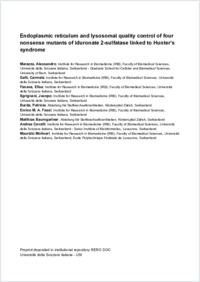Endoplasmic reticulum and lysosomal quality control of four nonsense mutants of iduronate 2-sulfatase linked to Hunter’s syndrome
- Marazza, Alessandro Institute for Research in Biomedicine (IRB), Faculty of Biomedical Sciences, Università della Svizzera italiana, Switzerland - Graduate School for Cellular and Biomedical Sciences, University of Bern, Switzerland
- Galli, Carmela Institute for Research in Biomedicine (IRB), Faculty of Biomedical Sciences, Università della Svizzera italiana, Switzerland
- Fasana, Elisa Institute for Research in Biomedicine (IRB), Faculty of Biomedical Sciences, Università della Svizzera italiana, Switzerland
- Sgrignani, Jacopo Institute for Research in Biomedicine (IRB), Faculty of Biomedical Sciences, Università della Svizzera italiana, Switzerland
- Burda, Patricie Abteilung für Stoffwechselkrankheiten, Kinderspital Zürich, Switzerland
- Enrico M. A. Fassi Institute for Research in Biomedicine (IRB), Faculty of Biomedical Sciences, Università della Svizzera italiana, Switzerland
- Matthias Baumgartner Abteilung für Stoffwechselkrankheiten, Kinderspital Zürich, Switzerland
- Andrea Cavalli Institute for Research in Biomedicine (IRB), Faculty of Biomedical Sciences, Università della Svizzera italiana, Switzerland - Swiss Institute of Bioinformatics, Lausanne, Switzerland
- Maurizio Molinari Institute for Research in Biomedicine (IRB), Faculty of Biomedical Sciences, Università della Svizzera italiana, Switzerland
-
2019
15
Endoplasmic reticulum
Formylation
Glycosaminoglycans
Hunter’s disease
Iduronate-2 sulfatase
Nonsense mutations
Lysosomal storage diseases
Lysosome
Molecular dynamics
Mucopolysaccharidosis type II
English
Hunter’s syndrome (mucopolysaccharidosis type II) is a rare X-linked lysosomal storage disorder caused by mutations in the iduronate 2-sulfatase (IDS) gene. Motivated by the case of a child affected by this syndrome, we compared the intracellular fate of wild type IDS (IDSWT) and of four nonsense mutations of IDS (IDSL482X, IDSY452X, IDSR443X and IDSW337X) generating progressively shorter forms of IDS associated with mild to severe forms of the disease. Our analyses revealed formylation of all forms of IDS at cysteine 84, which is a pre-requisite for enzymatic activity. After formylation, IDSWT was transported within lysosomes, where it was processed in the mature form of the enzyme. The length of disease-causing deletions correlated with gravity of the folding and transport phenotype, which was anticipated by molecular dynamics analyses. The shortest form of IDS, IDSW337X, was retained in the endoplasmic reticulum (ER) and degraded by the ubiquitin-proteasome system. IDSR443X, IDSY452X, IDSL482X passed ER quality control, were transported to the lysosomes, but failed lysosomal quality control resulting in their rapid clearance and in loss-of-function phenotype. Failure of ER quality control inspection is an established cause of loss-of-function observed in protein misfolding diseases. Our data reveal that fulfillment of ER requirements might not be sufficient, highlight lysosomal quality control as the distal station to control lysosomal enzymes fitness and pave the way for alternative therapeutic interventions.
- Language
-
- English
- Classification
- Biological sciences
- License
-
License undefined
- Open access status
- green
- Identifiers
-
- RERO DOC 328141
- DOI 10.1089/dna.2019.5221
- ARK ark:/12658/srd1319181
- Persistent URL
- https://n2t.net/ark:/12658/srd1319181
Statistics
Document views: 181
File downloads:
- Fulltext: 183
